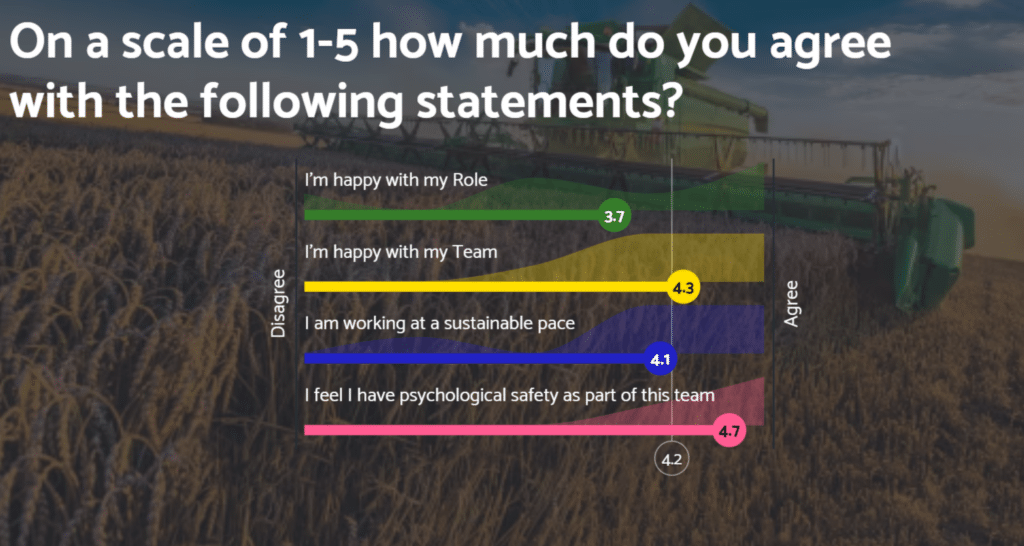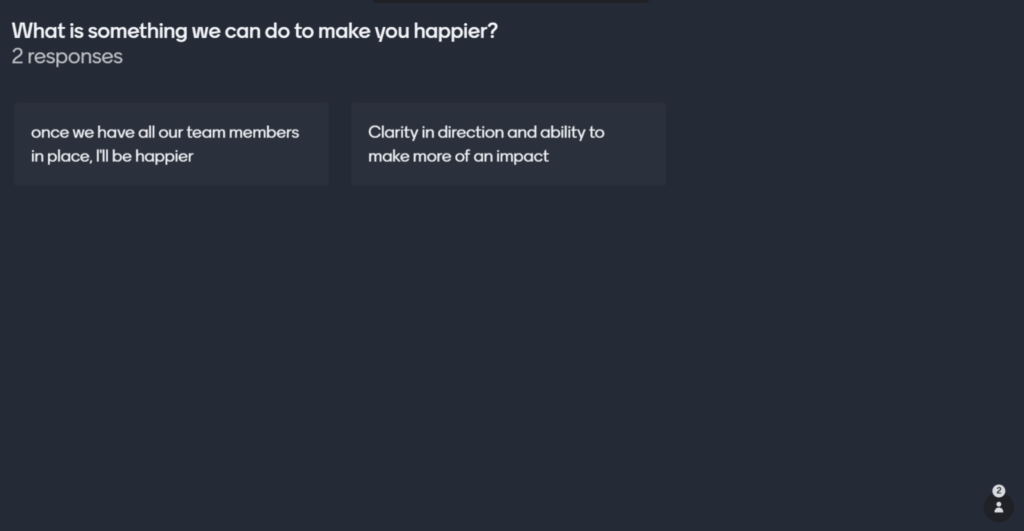At their core, happiness surveys offer insights beyond mere productivity metrics or output quality. They delve into the emotional and psychological state of team members, providing a holistic view of the workplace dynamics. It’s not just about how much is being accomplished but how team members feel about their roles, their relationships with colleagues, and their place within the organization. This comprehensive approach fosters a positive and productive work environment where individuals feel valued, understood, and motivated.
By measuring team happiness, organizations can identify potential stressors, gauge overall morale, and get a leading indicator of potential productivity issues before they escalate. Tracking happiness over time allows for the identification of trends and areas for improvement, making it possible to intervene proactively and make informed decisions that enhance the team’s well-being and, as a result, its overall performance.
In essence, happiness surveys act as a bridge between the quantitative and qualitative aspects of work life, enabling leaders to create a more empathetic, responsive, and ultimately successful workplace. This blog post will guide you through the process of conducting your first happiness survey, from setting clear objectives and choosing the right tools to analyzing results and taking meaningful action based on insights gained. Join us in exploring how to unlock the full potential of your team through the power of happiness surveys.
The Correlation Between Happiness, Productivity, and Team Cohesion
Research consistently shows that happy teams aren’t just more pleasant to be a part of; they’re also more productive. This isn’t a mere coincidence. When team members are satisfied and feel valued, their motivation surges. This heightened motivation translates directly into higher quality work, increased productivity, and an improvement in overall team performance. Happiness acts as a lubricant for the machinery of teamwork, enabling smoother interactions, fostering better communication, and facilitating more effective problem-solving.
The Benefits of Tracking Happiness Over Time
Measuring happiness within a team allows for a deeper understanding of the dynamics that contribute to or detract from its well-being. By tracking these metrics over time, leaders and teams can identify trends and patterns that might indicate emerging issues or areas ripe for improvement. For instance, a downward trend in happiness scores could preemptively reveal underlying issues that, if addressed promptly, could prevent more significant productivity downturns or quality issues.
Regular happiness surveys serve as a continuous feedback loop, providing insights that can be acted upon to enhance the work environment. This not only helps in making immediate improvements but also aids in long-term planning and strategy for team development and support.
A Leading Indicator of Potential Productivity Issues
Beyond the immediate benefits, tracking happiness can serve as a leading indicator of potential productivity issues. Changes in team morale often precede observable shifts in performance metrics, providing a valuable window for proactive intervention. By understanding the nuanced relationship between how team members feel and how they perform, leaders can anticipate challenges and address them before they impact the bottom line.
Measuring happiness is not just about ensuring a pleasant work environment; it’s about strategically leveraging team well-being as a critical component of organizational success.
Preparing for Your Happiness Survey

Setting Clear Objectives
Before launching your survey, it’s important to define what you hope to achieve. Are you looking to identify stressors within the team? Gauge overall team morale? Or perhaps you’re seeking a leading indicator of potential productivity issues. Clear objectives will not only guide your questionnaire design but also inform how you analyze and act on the data collected.
Choosing the Right Tool
Selecting the appropriate tool for your happiness survey is vital for facilitating ease of response and ensuring you can effectively analyze the results. Here are a few recommended tools, each with its pros and cons:
- Google Forms: User-friendly and versatile, Google Forms is an excellent option for those looking for a free, straightforward solution. It offers various question types and easy data analysis through integration with Google Sheets.
- Microsoft Forms: Similar to Google Forms, Microsoft Forms provides a simple interface and seamless integration with other Microsoft Office tools, making it a great choice for teams already using the Microsoft ecosystem.
- MentiMeter: For more interactive surveys, MentiMeter allows real-time feedback and engagement, making it ideal for live team meetings or workshops. However, it might require a subscription for full features.
- Excel: For teams comfortable with data manipulation, designing your survey in Excel and analyzing results with custom formulas can offer maximum flexibility. This approach might require more setup time and Excel knowledge.
Choosing the right tool depends on your team’s familiarity with these platforms, the complexity of the survey, and your specific needs for data analysis.
Crafting Your Survey
Questionnaire Design
Designing an effective and engaging questionnaire is crucial for obtaining meaningful insights. We recommend starting with questions about how happy team members are with their role, their team, and the organization using a Likert scale. Follow this with an open-ended question like, “What could be done to make you feel better?” This format encourages both quantitative and qualitative feedback, offering a well-rounded view of team happiness. Remember, the goal of your happiness survey is not just to measure but to understand and improve.

Administering The Survey
Timing and Frequency
Choosing the right time to conduct your happiness survey is crucial. You want to pick a moment when team members are most likely to provide thoughtful and honest feedback. Administering the survey every Sprint at the start of the Retrospective is highly recommended. This timing allows teams to reflect on their recent experiences while the details are still fresh, providing more accurate and actionable insights.
In terms of frequency, conducting a happiness survey at regular intervals—such as every Sprint—is what enables you to track changes over time and gauge the effectiveness of any interventions or changes you’ve implemented. Consistency is key to identifying trends and making informed decisions.
Encouraging Participation
High participation rates are critical to the success of your happiness survey. Here are some strategies to maximize engagement:
- Communicate the Purpose: Clearly explain why you’re conducting the survey and how the results will be used to improve the workplace. Knowing their feedback is valued and will lead to tangible changes can motivate team members to participate.
- Guarantee Anonymity (When Necessary): If you’ve chosen to conduct the survey anonymously, reassure participants that their responses will be confidential. This can help in eliciting honest feedback, especially on sensitive topics.
- Keep It Simple: Design your survey to be as lightweight and straightforward as possible. Long, complex surveys can be off-putting. Aim for questions that are easy to understand and quick to answer.
- Leverage Technology: Use one of the recommended tools (Google Forms, Microsoft Forms, MentiMeter, or Excel) to make the survey accessible and easy to complete. Choose a platform that is familiar to your team and can be easily accessed.
- Provide Regular Updates: Communicate the progress towards achieving a high response rate and remind team members of the survey deadline. Regular updates can keep the survey top of mind and encourage last-minute participants.
Analyzing the Results
Interpreting the Results
When you’ve collected your survey responses, the first step is to aggregate the data, particularly for questions using a Likert scale. This will give you an overall picture of how your team feels about their role, their team, and the organization. Look for patterns or trends in the responses, such as particularly high or low areas of satisfaction.
Balancing happiness with other metrics like velocity, quality, and value delivery is essential. While happiness is a critical metric, it should be considered alongside these other factors to provide a comprehensive view of team performance. For example, a very happy team with declining velocity or quality might indicate issues that aren’t being captured by the happiness survey alone.
Downward trends in happiness can be a leading indicator of loss of productivity in the near future. Pay close attention to these trends, as they can give you early warnings about potential issues before they fully manifest in other performance metrics.
Visualizing Data
Visualizing your survey data can make it easier for both you and your team to understand the results. Consider using bar charts to represent the distribution of responses to Likert scale questions or word clouds for open-ended questions to highlight common themes. Tools like Google Sheets or Microsoft Excel can help you create these visualizations easily.
When presenting the results to your team or stakeholders, ensure the data is accessible and understandable. Avoid overwhelming your audience with too much information at once; instead, focus on key findings and insights that are directly actionable.
Using Results as a Leading Indicator
The insights gathered from your happiness survey should inform your next steps in improving team satisfaction and performance. Consider scheduling a dedicated meeting with your team to discuss the survey results and brainstorm potential improvements based on the feedback received. This collaborative approach ensures that any actions taken are grounded in the team’s actual needs and concerns.

Taking Action on Survey Insights
Creating a Response Plan
- Consolidate Feedback: Start by grouping similar feedback points and identifying common themes. This helps in prioritizing issues that have the most significant impact on team happiness.
- Facilitate Retrospective Discussions: Use the happiness metric as a basis for retrospective discussions. Present the findings to the team and invite them to share their thoughts and suggestions on how to address the identified issues. This collaborative approach not only ensures that the team feels involved in the solution but also leverages diverse perspectives for more effective problem-solving.
- Develop Actionable Steps: Based on the discussion, outline specific, actionable steps that the team agrees to take. Assign responsibilities and set deadlines for these actions. The plan should be realistic and focus on incremental improvements rather than attempting to solve everything at once.
- Integrate into Future Plans: Incorporate the insights and action items from the happiness survey into the team’s future retrospective discussions and planning sessions. This ensures continuous attention to team happiness and productivity.
Communication and Follow-Up
- Transparent Communication: Share the survey results, along with the proposed response plan, with the entire team. Transparency is key to building trust and ensuring that the team feels heard. Acknowledge the issues raised and commit to addressing them.
- Implement and Track Actions: Begin implementing the agreed-upon actions and regularly track progress. Keep the team updated on developments and any challenges encountered along the way. Adjust the plan as necessary based on ongoing feedback and outcomes.
- Evaluate the Impact: After implementing the actions, evaluate their impact on team happiness and productivity. This assessment can be done through follow-up surveys or discussions during retrospectives.
- Plan for Follow-Up Surveys: Schedule regular happiness surveys to track progress over time. These follow-up surveys will help gauge the effectiveness of the actions taken and identify new areas for improvement. Adjust the frequency of the surveys based on the team’s needs and the pace of change within the organization.
Taking action on survey insights is not a one-off task but a continuous cycle of feedback, action, and evaluation. Remember, not taking action on the feedback received can be more detrimental to team morale than not asking for feedback at all. By systematically addressing the insights from your happiness survey, you demonstrate a commitment to your team’s well-being and foster a culture of continuous improvement.
Conducting a happiness survey is a powerful step toward understanding and enhancing your team’s work environment and overall morale. By carefully preparing, administering, and analyzing these surveys and then taking decisive action based on the insights gained, leaders can significantly impact their team’s satisfaction and productivity.








